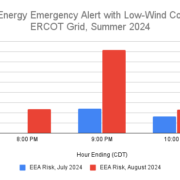Last Updated on November 14, 2022 by Mary Pressler
ERCOT NEWS – The Latest On the Texas Power Grid
At Quick Electricity, we’re Texans too. As winter approaches, most of us wonder about the stability of our electric grid and worry about repeat blackouts. We’ve dedicated this page to all things Texas electricity in an attempt to keep everyone informed and impowered. Bookmark this page as Texas Grid Updates and return often, as we will keep you in the loop about ERCOT.
The Texas PUC Plans to Improve Reliability With a Power Market Reform
Monday November 14, 2022
Texas has an energy-only electricity market, where power generators are only paid for kilowatt-hours that are actually delivered to the grid. Electricity prices are determined by supply and demand, which means they increase when power consumption is high with respect to generation. This happens on hot summer days when air conditioning takes the grid capacity to its limit, and it also happened in February 2021 during Winter Storm Uri.
An energy-only market ensures that power generators are only paid for electricity delivered, but it has a weakness: there is no incentive to keep generation capacity available for emergencies. Other states have both energy and capacity markets, and power companies are paid for:
- Energy that is actually delivered.
- Keeping generation capacity on standby, even if not required completely.
A capacity market makes the grid more reliable, but the downside is an increase in operating costs when generators are paid for availability. On November 11, the Public Utility Commission of Texas published a proposal that would create a capacity market based on a performance credit mechanism (PCM).
Understanding the Performance Credit Mechanism Proposed by the PUCT
The Performance Credit Mechanism (PCM) creates a market of “performance credits”, which are purchased from power generators, by retail electricity providers. The cash flow provided by these credits creates an incentive to keep generation capacity available for times of high demand. The mechanism has penalties to make sure that both parties comply, and this results in a guaranteed power supply for electricity consumers:
- Retail electricity providers (REP) are penalized for not purchasing performance credits.
- Power generators are penalized if they don’t provide the agreed generation capacity.
The PUCT published the new performance credit mechanism on Thursday November 10, and feedback will be received until the final vote on December 15, according to an article published by The Texas Tribune.
E3 Consulting, a Colorado-based firm, was hired by the PUCT to analyze their proposal. They determined that the performance credit mechanism would add around $460 million in annual operating costs to the ERCOT grid. This represents a 2-3% increase with respect to current costs, but the PCM could make the grid 10 times more reliable, according to an article by Austin-American Statesman.
 ERCOT Avoided Major Blackouts in Summer 2022, but at a Cost of $1 Billion
ERCOT Avoided Major Blackouts in Summer 2022, but at a Cost of $1 Billion
Thursday, September 15, 2022
Texas broke its own electricity demand record 11 times during summer 2022, according to an article by Reuters, exceeding 80,000 MW and surpassing the ERCOT forecast of 77,733 MW. There were concerns about the grid’s ability to remain stable during summer, and there was a general fear of widespread power outages like those from February 2021.
ERCOT has successfully avoided rolling blackouts in 2022, but this has cost Texas $1 billion during the first seven months of the year. Two particular measures have been very effective:
- Electricity generators are being paid to keep more power plant capacity on standby, in case of an emergency. The reserve margin has been increased by 50%.
- Large industrial consumers are being rewarded for cutting their consumption at times of peak demand.
Rolling blackouts were not necessary, even with record-breaking consumption during summer. However, Texans were asked twice to conserve electricity and raise their thermostats.
Texas is also dealing with power line congestion: generation is concentrated away from regions with high consumption, and transmission capacity is taken to its limit. Congestion costs reached $2.1 billion during the first seven months of 2022, according to the Independent Market Monitor. There have been times when kilowatt-hour prices peak in areas like Houston, while negative prices are reported in regions with extra generation – this means the grid does not have enough transmission and distribution capacity.
Update: The Texas Grid Has Been Holding Up During the Latest Ice Storm
Friday, February 4, 2022
Texas has been under an ice storm this week, raising concerns about major blackouts like those caused by Winter Storm Uri. However, the ERCOT grid is much more prepared this time, and last year’s storm was also more extreme.
- ERCOT has a 15,000 MW in reserve this time, according to CEO Brad Jones, and this is enough to power 11 million homes. Last year, the grid reached its limit and there was no way to bring more power plants online – there was zero margin of error.
- Texas also introduced weatherization requirements for power generators, to keep them from freezing like in February 2021. They had to comply by December 2021, and 99% of them passed the inspection.
- Natural gas suppliers have also been working to protect their equipment from harsh weather. They also brought extra crews to their sites ahead of the storm, in case of another emergency.
- Texas has also been improving communication between agencies, since this was a factor that slowed down their response during Winter Storm Uri.
No major blackouts have been reported as of Friday, February 4. However, there have been local outages, which are typically caused when power lines are damaged by ice or falling branches. These scattered power outages have affected around 70,000 Texas, but this is nowhere near the 4.5 million homes that were left without power in February 2021.
ERCOT has a live dashboard where you can see how the grid is operating, which can be accessed with the following link:
Texas Is Having an Unusually Warm Winter in 2021
Tuesday, December 21, 2021
Texas is having above-average temperatures this December, and many climate experts agree that having another severe winter storm in less than a year is extremely unlikely. The warmer-than-usual Christmas is caused by a combination of factors:
- The polar vortex is relatively stable this year, which means that large masses of cold air have remained above Canada and the Arctic. Winter storms are more likely when the polar vortex is unstable, since cold air masses can break away and reach farther south.
- The La Niña phenomenon has developed over the Pacific this year, and this generally leads to above-average winter temperatures in Texas and other southern states.
Surprisingly high temperatures have been forecast for the upcoming Holidays: Austin can expect a maximum temperature of 82°F on Christmas Eve, and 85°F on Christmas Day.
 The Public Utility Commission of Texas Is Changing the Energy Market
The Public Utility Commission of Texas Is Changing the Energy Market
Friday, December 17, 2021
The blackouts caused by Winter Storm Uri in February 2021 raised major concerns about the reliability of the Texas power grid. Currently, the state has an energy-only market where electricity is priced based on supply and demand.
- Generators are paid less when there is abundant power, and paid very high when electricity is scarce.
- However, PUCT Chairman Peter Lake refers to this as a “crisis-based business model”, which incentivizes generators to sell power when the supply is already tight and the grid is about to collapse.
On Thursday December 16, the PUCT approved several changes for the Texas energy market. The market will now reward power generators for their availability and reliability, and this includes payments for generators with onsite fuel storage, and for those who can respond quickly to grid frequency changes. To complement these measures, the PUCT will also introduce incentives for large consumers who can lower their demand when the power grid is burdened.
There have been mixed reactions to these changes. An energy market structure that rewards reliability can make the power supply more stable, representing an improvement beyond the current scarcity-based price model. However, energy experts and consumer advocacy groups are concerned that the recent market changes could increase electricity prices.
 ERCOT UPDATE
ERCOT UPDATE
Thursday November 18, 2021
The North American Electric Reliability Corporation (NERC) published the 2021-2022 Winter Reliability Assessment. They concluded that the ERCOT grid can operate without problems under normal winter weather. However, if there is another extreme weather event like Winter Storm Uri (February 2021), blackouts are very likely in Texas.
The latest NERC assessment covers the period from December 2021 to February 2022, and the following were some of their key findings and conclusions:
- Under normal conditions, the ERCOT grid will have 84.3 GW of generating capacity for the winter months, and the expected demand is 59.4 GW. This is equivalent to a reserve margin of 42%, which means there is more than enough capacity to provide electricity.
- However, extreme conditions have the potential to disable 28.1 GW of generation capacity, while raising demand up to 76.8 GW. In other words, the power supply can fall below demand under extreme conditions. In this scenario, the ERCOT grid would suffer large-scale blackouts like those from February 2021.
In the worst-case scenario, NERC has forecast a capacity shortfall of -37.1% for the ERCOT grid. However, this would require another extreme event like Winter Storm Uri, and this scenario is not expected with normal winter weather. NERC has estimated a 0.7% probability of having large-scale blackouts in Texas due to extreme weather during the 2021-2022 winter.




